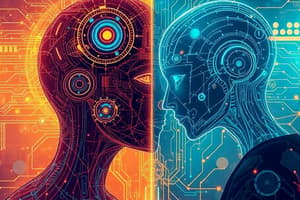Podcast
Questions and Answers
Which of the following is the MOST accurate characterization of the environmental impact of soil pollution, as described in the content?
Which of the following is the MOST accurate characterization of the environmental impact of soil pollution, as described in the content?
- It leads to respiratory diseases due to the release of harmful chemicals into the air.
- It negatively impacts crop productivity and threatens food security. (correct)
- It primarily contributes to climate change through increased greenhouse gas emissions.
- It primarily affects marine ecosystems by contaminating water sources.
How does the use of social media in digital politics MOST significantly impact civic engagement and political discourse?
How does the use of social media in digital politics MOST significantly impact civic engagement and political discourse?
- It can amplify political participation but also risks spreading misinformation and enabling political manipulation. (correct)
- It ensures that all political information shared is accurate and unbiased due to fact-checking algorithms.
- It creates a universal consensus on political issues by connecting individuals with shared ideologies.
- It exclusively promotes activism by providing a platform for organizing peaceful demonstrations.
How does the application of AI in automation MOST directly affect economic operations?
How does the application of AI in automation MOST directly affect economic operations?
- It primarily reduces the need for cybersecurity measures across all business sectors.
- It mainly decreases the demand for regulation in industries.
- It solely focuses on reducing operational costs without necessarily improving the quality of output.
- It greatly enhances productivity, optimizes workflow processes, and facilitates large-scale data processing. (correct)
What is the MOST significant ethical concern raised by human cloning and designer babies?
What is the MOST significant ethical concern raised by human cloning and designer babies?
Which of the following best describes the role of verbal communication in branding?
Which of the following best describes the role of verbal communication in branding?
How do logos, colors, typography, and imagery MOST effectively shape brand perception?
How do logos, colors, typography, and imagery MOST effectively shape brand perception?
In the context of cultural context, how does the Communication Accommodation Theory (CAT) explain adjustments in interpersonal interactions?
In the context of cultural context, how does the Communication Accommodation Theory (CAT) explain adjustments in interpersonal interactions?
What is the MOST direct effect of greenhouse gas emissions (GHGs) on the environment?
What is the MOST direct effect of greenhouse gas emissions (GHGs) on the environment?
How does the Muted Group Theory explain communication challenges faced by marginalized groups?
How does the Muted Group Theory explain communication challenges faced by marginalized groups?
How does context collapse alter communication?
How does context collapse alter communication?
Flashcards
Digital Communication and Online Communities
Digital Communication and Online Communities
Social media platforms enable communication but can lead to excessive usage and psychological issues.
Information Accessibility
Information Accessibility
The internet's fast information access faces challenges from the spread of inaccurate and intentionally false content.
E-Government and Digital Democracy
E-Government and Digital Democracy
Platforms enhance government services but raise significant cybersecurity risks.
Digital Politics
Digital Politics
Signup and view all the flashcards
Automation and AI
Automation and AI
Signup and view all the flashcards
E-Commerce and FinTech
E-Commerce and FinTech
Signup and view all the flashcards
Air Pollution
Air Pollution
Signup and view all the flashcards
Water Pollution
Water Pollution
Signup and view all the flashcards
Soil Pollution
Soil Pollution
Signup and view all the flashcards
Greenhouse Gas Emissions (GHGs)
Greenhouse Gas Emissions (GHGs)
Signup and view all the flashcards
Study Notes
Technology's Role in Society and the Environment
Social Impact
- Social media platforms like Facebook and Instagram facilitate communication and community but can lead to digital addiction and mental health issues.
- The internet provides fast information access, but misinformation and disinformation are increasing concerns.
Political Impact
- Online platforms streamline government services like tax filing and voter registration, but raise cybersecurity risks.
- Social media enables activism and political participation but can spread misinformation and be used for manipulation.
Economic Impact
- AI enhances productivity, optimizes workflows, and processes large data sets.
- Online marketplaces (Lazada, Shopee) and mobile banking(GCash, Maya) revolutionize business while creating cybersecurity and regulation concerns.
Environmental Impact
- Vehicle emissions and fossil fuel combustion cause air pollution, leading to respiratory diseases and climate change.
- Industrial and plastic waste pollutes water, causing diseases and contaminating water sources.
- Hazardous waste and chemical fertilizers pollute soil, impacting crop productivity and food security.
- Greenhouse gas emissions from CO₂ and CH₄ lead to global warming.
- Deforestation results in biodiversity loss and disrupted ecosystems.
Sustainable Technologies
- Renewable energy sources like solar and wind reduce GHG emissions but require significant initial investment.
- Precision farming and AI-driven agroforestry are sustainable agriculture methods that optimize resources.
- Waste-to-Energy (WTE) and smart recycling systems are waste management solutions that improve waste efficiency.
Biotechnology, Genetic Engineering, and GMOs
Biotechnology Applications
- GMOs like Bt corn and Golden Rice can improve yield and nutrition in agriculture.
- Insulin production and gene therapy are medical treatments that are aided by biotechnology.
- Cloning (Dolly the sheep) and transgenic animals (Enviropig) in animal science enhance livestock efficiency.
- GMO crops extend shelf life in food security (e.g., Arctic apples).
Ethical Issues in Genetic Engineering
- Human cloning and designer babies raise questions about identity, ethics, and genetic modification.
- GMO animals in animal welfare can impact ecosystems and ethical standards.
- Embryonic stem cell research is controversial, but adult stem cells provide alternatives.
- Patented GMO seeds in corporate control increase farmer dependency.
- There is no required GMO labeling law in the Philippines.
Space Exploration and Technological Innovation
Key Milestones
- Sputnik 1 (1957) was the first artificial satellite and sparked the Space Race.
- Apollo 11 (1969) was the first manned Moon landing.
- The International Space Station (1998-present) serves as a hub for scientific research.
- Mars Rovers (Curiosity & Perseverance) study Mars' climate and surface.
- The James Webb Space Telescope (2021) provides detailed images of distant galaxies.
Benefits of Space Exploration
- Scientific discoveries expand the knowledge of planetary systems.
- GPS, weather forecasting, and medical imaging are technological innovations that have resulted from space exploration.
- Satellites for environmental monitoring track climate change and natural disasters.
Challenges & Ethical Considerations
- Space exploration requires significant funding due to high costs.
- Radiation exposure and muscle atrophy are health risks that astronauts face.
- Space debris poses collision risks and chain reactions in orbit.
- Rocket launches from space exploration contribute to pollution which has an environmental impact.
Future of Space Exploration
- Mars Missions are planned by NASA and SpaceX.
- NASA’s Artemis program plans to achieve Lunar colonization.
- Companies like Virgin Galactic provide space tourism through commercial space flights.
Verbal Communication in Branding
Crafting Brand Messages and Taglines
- Verbal communication turns a brand into a relatable entity, not just an image.
- Brand messages define the brand's identity, purpose, and significance.
- A tagline is a concise, memorable statement capturing the brand's core essence.
Types of Taglines
- Imperative taglines call to action (e.g., Apple: "Think Different.").
- Descriptive taglines describe brand value (e.g., Target: "Expect more. Pay less.").
- Superlative taglines position the brand as the best (e.g., BMW: "The ultimate driving machine.").
- Provocative taglines challenge or provoke thought (e.g., Dairy Council: "Got Milk?").
- Specific taglines highlight a product focus (e.g., Skittles: "Taste the Rainbow.").
Steps to Crafting the Perfect Tagline
- Get Inspired by analyzing competitor taglines.
- Review Brand Fundamentals to align with vision, mission, and values.
- Brainstorm Ideas to consider emotional and practical benefits.
- Condense Ideas into a short, impactful phrase.
- Polish and Refine for clarity and maximum impact.
- Test Taglines to observe audience reactions.
Considerations in Crafting Messages
- Clarity means avoiding jargon (e.g., Google: "Organize the world's information.").
- Consistency means aligning with visual identity (e.g., Apple: "Think Different.").
- Emotional Appeal builds loyalty (e.g., Dove: "Real Beauty.").
- Memorability entails using rhythm and wit (e.g., LBC: "Hari ng Padala.").
- Relevance means reflecting audience interests (e.g., "It’s More Fun in the Philippines.").
Visual Communication in Branding
The Role of Design in Branding
- Visual communication conveys a brand’s identity, values, and message.
- Brand perception is shaped via logos, colors, typography, and imagery.
- Recognition, differentiation, and emotional connection are fostered by a strong visual identity.
Fundamental Principles of Visual Communication
- Visuals should be tailored to demographics and psychographics to Understand Your Audience.
- Brand guidelines for fonts, colors, and logos are needed to maintain consistency.
- Infographics, motion graphics, and illustrations can leverage Visual Storytelling and simplify messages.
- Color theory, typography, and composition can be enhanced by mastering Graphic Design Principles.
- Aligning with trends while maintaining brand authenticity is needed to enhance Marketing Campaigns.
- Educating, informing, and engaging consumers are needed to ensure visuals provide value.
Key Visual Elements
- The color palette impacts brand perception (e.g., blue = trust, red = excitement).
- A logo is a graphic symbol that identifies a brand (e.g., Nike swoosh, Apple logo).
- The typography sets the tone (e.g., bold fonts for impact, minimalist fonts for elegance).
- Photos, icons, and illustrations reinforce brand identity with imagery.
- Layouts use balanced composition and whitespace to guide user attention.
- Packaging design is The "silent salesman" that influences purchase decisions.
Design Trends
- Minimalist designs use clean layouts (e.g., Apple).
- Bold typography commands attention (e.g., Netflix).
- Sustainability aesthetics use eco-friendly visuals (e.g., Patagonia).
- Gradients & dynamic colors add depth and energy (e.g., Instagram).
- Motion graphics enhance engagement (e.g., Spotify).
- 3D Visuals create immersive branding (e.g., Coca-Cola).
Cultural Context
Intercultural Communication
- Culture is a code of symbols, beliefs, and meanings we transmit and assimilate.
- Intercultural communication studies how people communicate within specific cultures.
Theories on Intercultural Communication
- Communication Accommodation Theory (CAT) adapts their communication to reduce social distance (convergence) or emphasize differences (divergence).
- Face-Negotiation Theory manages public self-image through verbal and nonverbal strategies.
- Co-cultural Theory explores communication between dominant and marginalized groups.
Gender and Communication
- Sex refers to biological traits (chromosomes, hormones).
- Gender refers cultural attitudes, behaviors, and identities linked to sex.
- Feminist Standpoint Theory highlights how social location (gender, race, class) affects communication.
- Muted Group Theory argues that language is male-dominated and marginalizes women's voices.
Mass Communication Theories
Media Effects Theories
- Media has a direct, immediate, and powerful impact based on the Magic Bullet Theory.
- People remain silent on controversial issues if they feel they’re in the minority according to the Spiral of Silence Theory.
- Heavy TV watchers develop fear and paranoia, called "Mean World Syndrome," based on Cultivation Theory.
- Agenda-Setting Theory says media influences what issues people think about.
Media and Culture Theories
- Media environments shape the human experience according to Media Ecology.
- Technology blurs boundaries between private and public communication because of Context Collapse.
- Semiotics involves media signs carrying deeper ideological meanings.
- Cultural Studies finds that media helps maintain power structures.
Media and Society Theories
Mass Society Theory
- Media controls public thought and supports dominant institutions.
Mediatization Theory
- Media has become a core part of societal structures.
Political Economy of Media
- Media ownership leads to monopoly, commodification, and reduced diversity.
Studying That Suits You
Use AI to generate personalized quizzes and flashcards to suit your learning preferences.




